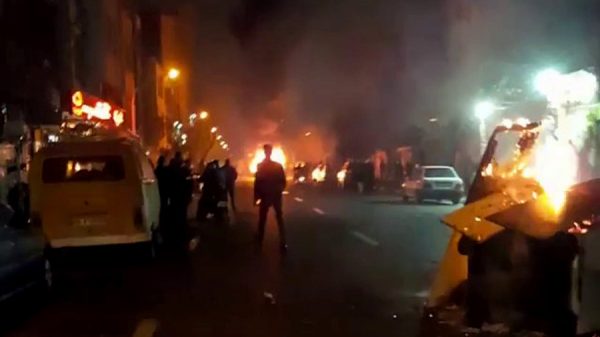
Opponents of Iran’s President Hassan Rouhani might have been secretly pleased when protestors in the northeast Iranian city of Mashad took to the streets last Thursday against rising prices and worsening living conditions. But what began as peaceful demonstrations have gradually turned into a violent uprising sweeping the whole of Iran, raging not just at Rouhani’s moderate government, but at the very regime itself.
From far-flung townships to the capital Tehran, for nearly a week now protestors have gathered in spite of efforts by security forces to prevent and disperse them.
Although there are echoes of the 2009 protests following the disputed re-election of Mahmoud Ahmadinejad, these demonstrations are in fact quite different. Although far fewer people are taking part than the millions who marched over eight years ago, these are more spread out. A source told TIME protests took place in a total of 38 cities on Jan.1. In some remote areas where unrest broke out, protests against the state had not been seen since the 1979 Islamic Revolution.
The demonstrations have been sporadic rather than pre-planned, many by protestors under the age of 25. They have also been more violent; at least eight protestors were killed on Monday alone, and two security forces.
The official reaction was to swiftly blame the Islamic Republic’s enemy states, from the United States to Israel and Saudi Arabia for stoking up violence and dissent. Both U.S. President Donald Trump and Israeli Prime Minister Benjamin Netanyahu of Israel quickly voiced their support for the protests.
But analysts believe the root cause lies within Iran itself. “What we are seeing now is the result of a sort of distrust between the state and the people,” Amir Mohebbian, a political analyst and professor, said on Tuesday. “Politicians and statesmen, instead of trying to solve the problems of the populaces, are continually busy aggrandizing issues and blaming the other side for it.”
Indeed, some in the political sphere have whipped up popular anger in the service of electoral support. In the buildup to last year’s presidential election, the loose coalition of conservative and hardline political factions who call themselves the Principalists had attacked the President for failing to improve the economy or alleviate the financial plight of lower and middle-class Iranians. The Principalists had hoped to attract the support of the working classes for their candidate, Ebrahimi Raeesi. In the end Rouhani secured a second four-year term, and Raeesi came in a distant second.
But that popular dissatisfaction endured long after the election was over. Frustration too has built up among many working-class Iranians over what they see as rampant corruption and cronyism in the upper echelons of society, as well as stifling class inequality. The moderate government of Rouhani has apparently failed to provide any tangible difference to their lives, and disillusionment has begun to set in. The much-vaunted nuclear deal between Iran and six world powers, including the U.S., has not turned around Iran’s economy and created jobs and opportunity, as the Iranian President promised.
Analysts say the never-ending squabbling and infighting between the different political factions of the Islamic Republic has also weakened trust in the state. “The immature behavior of political factions, and the never-ending blame game they play has lead to Iranians thinking that government and state institutions are all either too corrupt or too weak to solve their problems,” Mohebbian says. “All state institutions need to physically show to the people that their problems and issues are being solved.”
Until they can, the state seems to be quelling the unrest by blocking popular messaging app Telegram and social platform Instagram to prevent demonstrators from coordinating and organizing. It has also beefed up the presence of security forces on the streets to levels not seen since 2009, and initiated a wave of arrests and detentions of protestors and students and activists. More than 450 have been arrested in Tehran, and hundreds more across the country.
Reformists, however, suggest this surge of unrest might have been inevitable. One activist, who declined to be named out of fear of retribution, paraphrased the leader of the 2009 Green Movement Mir Hussein Mousavi, who has been under house arrest since 2010. “The Green Movement was the last time anybody tried to bring about change in the Islamic Republic peacefully,” they said. “When peaceful demonstrations are viciously suppressed, it is only natural that they will be replaced by violent protests.”
TIME
Leave a Reply
You must be logged in to post a comment.